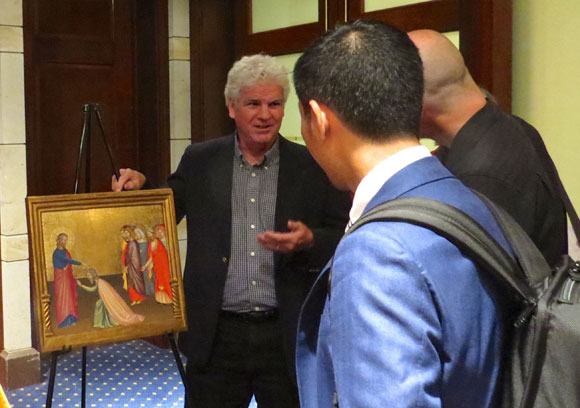
Faculty members from the Information Initiative at Duke (iiD) on June 9 joined the chief curator from the North Carolina Museum of Art for a Capitol Hill briefing discussing research projects at the intersection of mathematics and the arts.
Guillermo Sapiro, Pratt School Professor of Electrical and Computer Engineering, discussed his work using emerging technologies such as 3D printing to create an interactive exhibit that traces the history of works of medieval art in the Brummer Collection at Duke's Nasher Museum of Art.
Ingrid Daubechies, James B. Duke Professor of Mathematics, and William Brown, chief curator at the North Carolina Museum of Art also presented a discussion of their work to develop software to digitally remove the protective cradling that obscures "x-ray" images of art panels. They plan to use the software in their collaborative study of the Peruzzi altarpiece by Giotto and in the replication and rejuvenation of another 14th century altarpiece. These studies are in preparation for a fall 2016 exhibition that will reunite altarpiece panels now spread over four different museums in the United States.
The iiD is a place where multidisciplinary teams come together to make sense of "big data" -- sources of information characterized by massive size, tremendous variety and rapid change. Duke faculty and student look to harness massive data sets to address challenges ranging from the precise detection of explosives, to early diagnosis of autism and the identification of counterfeit art.
By collaborating with artists, art historians and museum conservators, scientists at iiD are learning to use big data to advance our knowledge of mathematical sciences. In turn, the answers to these questions increase our understanding of the fine arts in unexpected ways. Speaking at the briefing, Robert Calderbank, director of the iiD, said these projects represent "the center of gravity of the initiative's work," projects where the "data sets are complex or have holes."
The briefing attracted a diverse cross section of the Washington community -- including a member of Congress who holds a PhD in mathematics, and staff members from the Library of Congress, art institutions and NC congressional offices.
Below: William Brown talks with members of the DC community at the Duke briefing on art and mathematics research.
